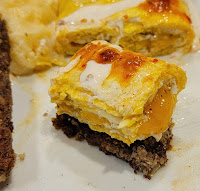Basic Ingredients
For a plain, but delicious Japanese omelet:- 2 large chicken eggs
- one teaspoon of dashi
- one bottle cap of mirin
- 2 tabs of butter
Basic Hardware
NOTE: A list of exact brands can be found at bottom of page.
- a frying pan (preferably cast iron, Japanese version of pan is square)
- a non-metal spatula (the wider the better)
- a fork
- a small bowl
Instructions
These should be performed in order, without delay.
- Clean your pan surface. The whole process only works if your pan surface is smooth.
- Read all the following instructions before doing anything else. You have been warned.
- Set your pan on a burner at MEDIUM LOW. That's 3 of 10 for most electric stovetops.
- While pan comes to temperature (usually takes around 5 minutes to stabilize) combine the eggs, dashi, and mirin in a small bowl.
- Chop the egg mixture against side of bowl with fork to mix. Thank you, Jacques Pepin.
- After pan has achieved temperature, add 1 tab of butter and lift pan off burner. Roll pan to coat.
- If the butter turns brown, your stupid burner is too hot. Turn it down just a little and think about buying a real stove.
- Pour half the egg mixture into the pan and roll the pan to coat consistently. Return to burner.
- Watch the egg until there is almost no eggy liquid on top. It will cook to yellow very quickly. Do not wait for the entire egg to solidify. Making tamagoyaki has wiggle room as long as you observe some minor egg liquid. If the entire thing looks cooked throughout, you have overcooked it. Try again tomorrow.
- Use the wide spatula to release the edges of the omelet, and softly fold in thirds.
- Now, scoot the small egg rectangle stack to the back of the pan.
- Add the second tab of butter to the open surface, raise pan, and roll to coat. Professional omelet chefs use a tongue with a buttered paper towel or cloth for this step, but keep egg stack against edge.
- Add the second half of the egg mixture to the pan, from one edge to the other side, flowing into the base of the existing tamagoyaki stack.
- Watch the egg egg, similar to step 9. When there is just a little liquid left on the top, fold starting with the existing egg stack in thirds again, snowballing the rectangle into an inch-thick pillow of eggy heaven.
- If your pan has a square edge, park the egg against it for 2 seconds, allowing the liquid that slid out during final fold to encounter the pan and cook prior to serving.
- Use your spatula and move final tamagoyaki to plate. Let it sit for 30 seconds while the omelet's interior solidifies from the heat of all the interior layers. This is what causes the entire thing to produce: a non-trivial omelet of uniform height, cooked throughout, but without being dry.
- Turn off the burner and allow the pan to cool (not on the burner).
- Salt and pepper to taste. Give thanks for the blessing you are about to consume. Itadakimasu!
Always add these after the first phase of egg folding prior to second pour to keep them from destroying the beautiful yellow pillow you worked so hard for. For easier folding, place them in a line between a boundary of thirds in a very thin layer.
- Green onions (whites during cooking, and fresh green over the finished product).
- Shallots (this requires you to get the shallots glassy prior to starting the tamagoyaki).
- Cheese (cheddar works just fine and produces a nice gooey visual akin to thick hollandaise, but ricotta, and even cottage cheese would be great as a healthier option).
- Bonito flakes (if you're going there, you may as well go all in).
- Ham of any kind: thin canadian bacon, country ham,
- Hot sauce (for those who don't like heat, Cholula Chili Lime is fantastic on these).
- Cacique® Crema Mexicana (only 3mg of sodium, adds a richness without making it taste like a giant breakfast burrito).
- Cilantro (duh)
- Diced tomatoes. I create a layer from thinly sliced Campari tomatoes akin to a tart.
- Nori. This one is delicious BUT be sure to add it while the egg is still liquid, otherwise the nori will not have enough moisture to fold. Also, don't use too much. Enough to cover two thirds of a single egg phase will more than suffice.
- Sambal Oelek (oh heck yeah, bring on the heat)
Non-obvious Ingredients to be Used in the Future
These are listed alphabetically to avoid bias (and probably should not be combined, except the plantains and mole... that would probably be fantastic):
- chilaquilles
- hashbrowns
- fried plantains
- fried rice
- linquica
- lox
- mole
- sumac
- tapenade
- tobiko
Links to Gear
- The pan I personally use: Amazon.com: Iwachu Iron Tamagoyaki Omelette Pan, Black: Home & Kitchen
- My go-to dashi: Amazon.com : Kikkoman Hon Tsuyu Soup Base Koidashi, 17 Fl Oz (Pack of 3) : Asian Sauces : Grocery & Gourmet Food
- A decent tamagoyaki spatula: Amazon.com: Minchsrin Silicone Wrapped Plastic Fish Spatula Pancakes Shovel Non-Stick Heat-Resistant Wide Flat Turner For Egg Tamales Pizza (Green) : Patio, Lawn & Garden
- Amazon.com : Kikkoman Aji-mirin, 10 Fl Oz (Pack of 4) : Balsamic Vinegars : Grocery & Gourmet Food



